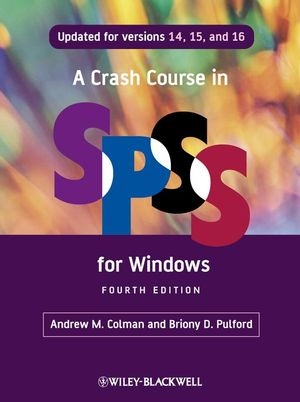
A Crash Course in SPSS for Windows
Wiley-Blackwell (an imprint of John Wiley & Sons Ltd) (Verlag)
978-1-4051-8402-1 (ISBN)
- Titel ist leider vergriffen;
keine Neuauflage - Artikel merken
This quick, simple, and user-friendly introduction to SPSS for Windows has now been updated so that it can be used with Versions 14 to 16 of the software. For this edition, a section has been added on partial correlation, together with new material on sorting, classifying, and coding data, inserting variables and cases, and paneling charts and graphs, and the chapter on charts and graphs has been completely rewritten in line with changes to the SPSS Chart Builder. The supporting website allows data sets used in the book to be downloaded from the Internet and provides additional examples from various social science disciplines. The fourth edition retains all of the features that have made the text so attractive to students and teachers:* The material is concise and focused, enabling most users to learn the basics comfortably within 10 hours.* All the most widely used statistical techniques and graphic facilities in SPSS for Windows are clearly described.* Every statistical procedure is explained with the help of a step-by-step analysis of a numerical example taken from real data in published research.*
The authors have chosen small data sets so that readers do not waste unnecessary time inputting data.* Screenshots on the page make it easy for students to cross between the text and the screen. Online support material to accompany the text is available at www.blackwellpublishing.com/crashcourse/
Andrew M. Colman is Professor of Psychology at the University of Leicester and an Academician of the Social Sciences. His previous publications include numerous journal articles and several books, including the award-winning Oxford Dictionary of Psychology (2001, 2006, 2009). Briony D. Pulford , Lecturer in Psychology at the University of Leicester, is an experienced researcher and data analyst. She has published extensively in academic journals, and has taught undergraduates how to use SPSS over many years.
Preface to the Fourth Edition. Choosing an Appropriate Statistical Procedure. Where to Find Things in SPSS. 1. Introduction . 2. Using Windows . 2.1 Running SPSS for Windows. 2.2 Resizing and moving a window. 2.3 The Data Editor. 2.4 Entering data. 2.5 Scrolling. 2.6 Saving data. 2.7 Exiting SPSS for Windows. 3. Loading Data and Printing . 3.1 Loading data. 3.2 Printing an entire data set. 3.3 Printing a selection of data. 4. General Descriptive Statistics . 4.1 Analysing data. 4.2 Means, standard deviations, and other measures. 4.3 Cutting and pasting. 4.4 Pasting data into a Word document. 5. Correlation Coefficients . 5.1 Background. 5.2 Pearson's correlation coefficient. 5.3 Spearman's rho. 6. Chi-square Tests . 6.1 Background. 6.2 The chi-square test of association. 6.3 Naming variables and labelling values. 6.4 Data input and analysis. 6.5 The chi-square goodness-of-fit test. 7. Independent-samples, Paired-samples, and One-sample t Tests . 7.1 Background. 7.2 The independent-samples t test. 7.3 The paired-samples t test. 7.4 The one-sample t test. 8. Mann-Whitney U and Wilcoxon Matched-pairs Tests . 8.1 Background. 8.2 The Mann-Whitney U test. 8.3 The Wilcoxon matched-pairs test. 9. One-way Analysis of Variance . 9.1 Background. 9.2 Data input. 9.3 Analysis. 9.4 Results. 10. Multifactorial Analysis of Variance . 10.1 Background. 10.2 Data input. 10.3 Analysis. 10.4 Results. 11. Repeated-measures Analysis of Variance . 11.1 Background. 11.2 Data input. 11.3 Analysis. 11.4 Results. 12. Multiple Regression . 12.1 Background. 12.2 Data input. 12.3 Analysis. 12.4 Results. 13. Log-linear Analysis . 13.1 Background. 13.2 Data input. 13.3 Analysis. 13.4 Results. 14. Factor Analysis . 14.1 Background. 14.2 Data input. 14.3 Analysis. 14.4 Results. 15. Charts and Graphs . 15.1 Background. 15.2 Bar charts. 15.3 Pie charts and simple line graphs. 15.4 Multiple line graphs. 15.5 Scatterplots. 16. Handling Variables and Large Data Files . 16.1 Recoding to create new variables. 16.2 Computing new variables. 16.3 Handling large data files. 17. Syntax Windows . 17.1 Background. 17.2 A worked example. 17.3 Some syntax procedures. Appendix 1: Handling Dates. Appendix 2: Exporting and Importing Excel Files. References. Index
| Verlagsort | Chicester |
|---|---|
| Sprache | englisch |
| Maße | 188 x 233 mm |
| Gewicht | 496 g |
| Themenwelt | Geisteswissenschaften ► Psychologie |
| Mathematik / Informatik ► Mathematik ► Computerprogramme / Computeralgebra | |
| Schlagworte | Psychologie • SPSS |
| ISBN-10 | 1-4051-8402-7 / 1405184027 |
| ISBN-13 | 978-1-4051-8402-1 / 9781405184021 |
| Zustand | Neuware |
| Haben Sie eine Frage zum Produkt? |
aus dem Bereich


